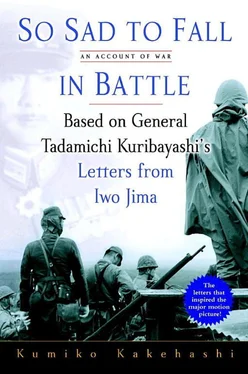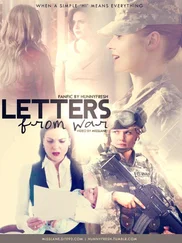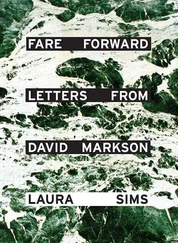War-lesson telegrams were always addressed to the chief of staff at Imperial General Headquarters because they were considered useful input for subsequent strategic planning and battle directives. Addressing one to the chief aide-de-camp of the emperor was thus a case of “getting the wrong man,” something that would never occur under normal circumstances.
Just like any other “war-lesson telegram,” this telegram purports to be addressed to the vice chief of staff, but there is a note at its head that reads: “This telegram should be communicated to Hasunuma, chief aide-de-camp to the Emperor.” The text, too, is directed at Hasunuma personally. “With the end of my life before me, I express my heartfelt thanks for your many years of kindness, and I pray that Your Honor will enjoy good fortune in war for a long time,” says the last sentence—the whole thing reads like a final message to Hasunuma.
Why should Kuribayashi do this? The answer to that question lies in the second atypical feature of this war-lesson telegram. This second anomaly is the war lesson itself. In his analysis of the battle, Kuribayashi is overtly critical of the policies of the Imperial General Headquarters.
There are two points to the critique. First, it says that headquarters personnel were not wholeheartedly committed to the policy of inland defense and “endurance engagement with heavy bloodshed,” but remained attached to the old doctrine of defense at the water’s edge.
The Imperial General Headquarters had switched to a policy of inland defense in August 1944. On Iwo Jima, this did not translate into committing 100 percent of resources into their inland defenses, as the garrison was also ordered to build defensive positions at the water’s edge. The navy was particularly stubborn in its insistence on constructing positions on the shore.
Although the military command realized from what had happened in Saipan that it was impossible to destroy the enemy at the water’s edge, they were still incapable of making a bold policy U-turn. They retained a vestigial belief in shoreline defensive positions, with the result that Iwo Jima’s defenses were neither one thing nor the other.
“Given the enemy’s supremacy at sea and in the air, it was impossible for us to prevent them from landing. We should therefore not have been unduly concerned about their landing per se, but should have focused on our inland defenses and making dispositions accordingly,” says the message. “We needed to prepare the key strong points of the main defenses thoroughly. The reason we could not do that was that much material, manpower, and time were squandered on the water’s edge defenses I mentioned above.” The most serious problem is that the main defenses remained uncompleted because of a policy that did not focus fully on either goal.
The second criticism was that the men were made to work on expanding the airfield until immediately prior to the American landing, despite no longer having airplanes. The telegram says: “Due to orders from the navy central command, manpower was diverted for the expansion of No. 1 and No. 2 airfields right up to the point when it was clear that the enemy intended to invade, and this despite the fact that we had no planes. Our defenses thus grew weaker and weaker, which is deplorable.”
Iwo Jima was originally conceived of as an unsinkable aircraft carrier out at sea. In accord with that, the original number-one priority had been to maintain and enlarge its airfields. But it flew in the face of logic not just to retain that policy, but to actually divert manpower for airfield expansion when it was almost certain that the Americans would invade and the most important challenge was to help the island hold out as long as possible. To top it all off, they had almost no usable airplanes, and ultimately the airfield the Japanese worked so hard to expand ended up being used by the Americans to conduct air raids on the Japanese homeland.
These two problems—the lack of thoroughness in implementing inland defense and the stubborn focus on the airfields—were both the result of the navy sticking to its original policies. Kuribayashi was an army lieutenant general, but he was also the commander in chief of Iwo Jima, meaning that the navy came under his authority. The navy, however, had its own way of doing things, and this prevented Kuribayashi’s policies from being fully implemented.
There was antagonism between the navy and the army on Iwo Jima while the defenses were being built, and it persisted until the American landing. For Kuribayashi, the cause of this was the central commands of army and navy being at odds with each other, something that stopped them from having a consistent and integrated defense strategy for the island. As he points out in the war-lesson telegram: “The crucial thing is to get rid of the tendency of the army and navy to be territorial, and for both parties to become unified.”
This war-lesson telegram is recorded in the official history, but the part that criticizes the army and navy for their territoriality and urges them to unite is omitted. The National Institute of Defense Studies compiled the official history, but it seems that the rivalry between the army and the navy was a taboo they wanted to steer well clear of, even in the age of the postwar Self-Defense Force.
Kuribayashi must have known that a message like this stood a good chance of being ignored if addressed directly to the Imperial General Headquarters. That is why he resorted to sending it to a former professor whom he trusted implicitly.
How did Chief Aide-de-Camp Hasunuma act when he received it?
The Diary of Kido Kôichi (Marquis Kido Kôichi was Lord Keeper of the Privy Seal) contains the following entry for March 9, 1945: “At 12:30 the chief aide-de-camp [Hasunuma] came into the room and we spoke about unifying the high command and so forth.” “Unifying the high command and so forth” is the matter of unifying the army and the navy—the very subject Kuribayashi broached in his war-lesson telegram.
The question of whether or not to unify the army and the navy was being debated in Japan at the time. There was nothing new about the problem of the two services not coordinating with each other or being at each other’s throats, but with the final battle for the homeland looming, it was reemerging as a very serious issue.
On February 26, a top-level meeting of the Army Central Office determined the “Basic Principles for Successful Execution of the Final Battle for the Homeland,” and made the unification of the army and the navy a key theme. Based on this document, negotiations were held between the army and the navy beginning March 3. It was right at this time that Chief Aide-de-Camp Hasunuma met Lord Keeper of the Privy Seal Kido to discuss this subject.
Kuribayashi sent his final war-lesson telegram from Iwo Jima at 11:00 p.m. on March 7. The Imperial General Headquarters received it and passed it on to the vice chief of staff at 7:15 a.m. on March 8. Since Chief Aide-de-Camp Hasunuma paid his visit to Lord Keeper of the Privy Seal Kido at 12:30 p.m. on March 9, he must have gone to meet him after having read Kuribayashi’s telegram. Hasunuma obviously understood that Kuribayashi was trying to communicate what things were really like on the front lines.
Ultimately, the unification of the army and the navy never came to pass. Although the top brass of the two services held meetings, they were unable to find common ground, and on March 26, former war minister Sugiyama reported their conclusion to the emperor: the unification of the army and the navy was “difficult and problematic.” Their lack of unity on thinking about strategy persisted until the end of the war.
The words that conclude Kuribayashi’s final war-lesson telegram can be seen as a criticism of the whole reckless war: “Most fatal for our defense is the enormous material gap between the two sides that places such a gulf between us. Ultimately we simply do not have the capacity to successfully implement any tactics or countermeasures.”
Читать дальше












